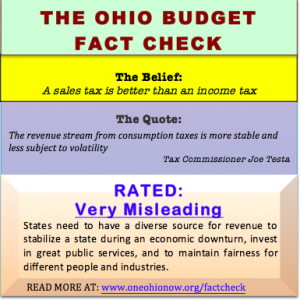Share This!
 BELIEF: A sales tax is better than an income tax
BELIEF: A sales tax is better than an income tax
RATING: Very Misleading
The Governor proposed shifting the tax burden in Ohio from the income tax to the sales tax. Ohio has a slightly less regressive tax structure than most states right now, because our income tax produces 44% of our state general revenues. Many anti-tax organizations and individuals, in an effort to shrink government, are now claiming that income taxes are too ‘volatile’ during an economic recession. The truth is that all taxes are vulnerable to economic downturns and changes in the economy. Ohio can address economic volatility by increasing our rainy day fund maximum and proper planning. Cutting a revenue source will not help guard against economic downturns.
We need to protect a strong income tax in Ohio because it is the only tax levied based on a person’s ability pay. Sales and property taxes are levied on all residents regardless of income. In Ohio, the poorest 20% of people pay about 5% more of their income towards state and local taxes than the top 1% do. The income tax helps to balance out the inequities within state and local taxation. Without the income tax, the difference could potentially double.
It is true that revenue from an income tax may decrease during a recession, but so do all taxes. Depending on the type of economic downturn revenue from property or sales taxes may fall faster and farther than income tax revenues. Research shows that state sales tax revenues fall during an economic downturn but are less responsive when the economy starts to emerge from the recession. Revenues from an income tax will grow quicker during a recovery because of the graduated nature of the income tax. Public investments into infrastructure, education, and public safety can be vital in creating a strong economic recovery. Cutting income taxes now denies Ohio the opportunity to collect revenues that can restore delayed projects, enhance our public investments, and shore up budgets for the future.
We cannot be overly reliant on one source of revenue, either. Ohio’s schools are a prime example of what happens when you are over-reliant on one source of funding. During the last recession, Ohio property values fell dramatically, and the local tax collections fell too. This was particularly hard on our public schools that are over-reliant on property taxes. Local districts did receive some federal support to meet their budgets during the recession. However, the state was unable to help, primarily due to the 2005 income-tax cut that was still being phased in. Ohio now has additional revenue at the state level because of the quick rebound in the income tax collections, but local communities and schools that rely on sales and property taxes continue to struggle. With the cuts to revenue sharing, the economic recovery is not felt by local governments and schools.
All tax revenues are volatile during a recession, like the one we just experienced. Replacing an income-tax with a sales tax will only decrease revenue and not volatility. We cannot allow anti-tax organizations to latch into a new argument for dismantling the Ohio income tax. We need a strong and progressive income tax, a state sales tax, and local property taxes to have a balanced approach to generating revenues for great public services that lead to stronger communities. The Ohio House of Representatives will begin looking at long-term tax reform in early May 2013, and they need to understand that volatility is not a substantial argument for cutting the Ohio income tax.









